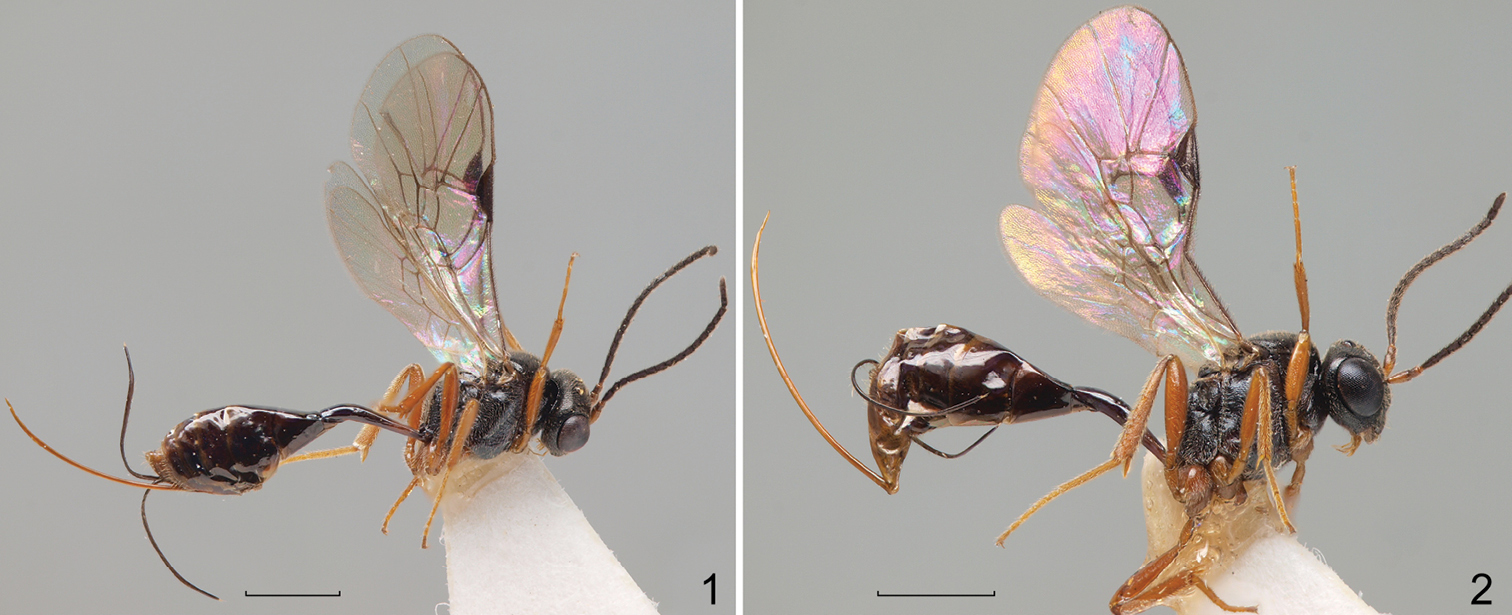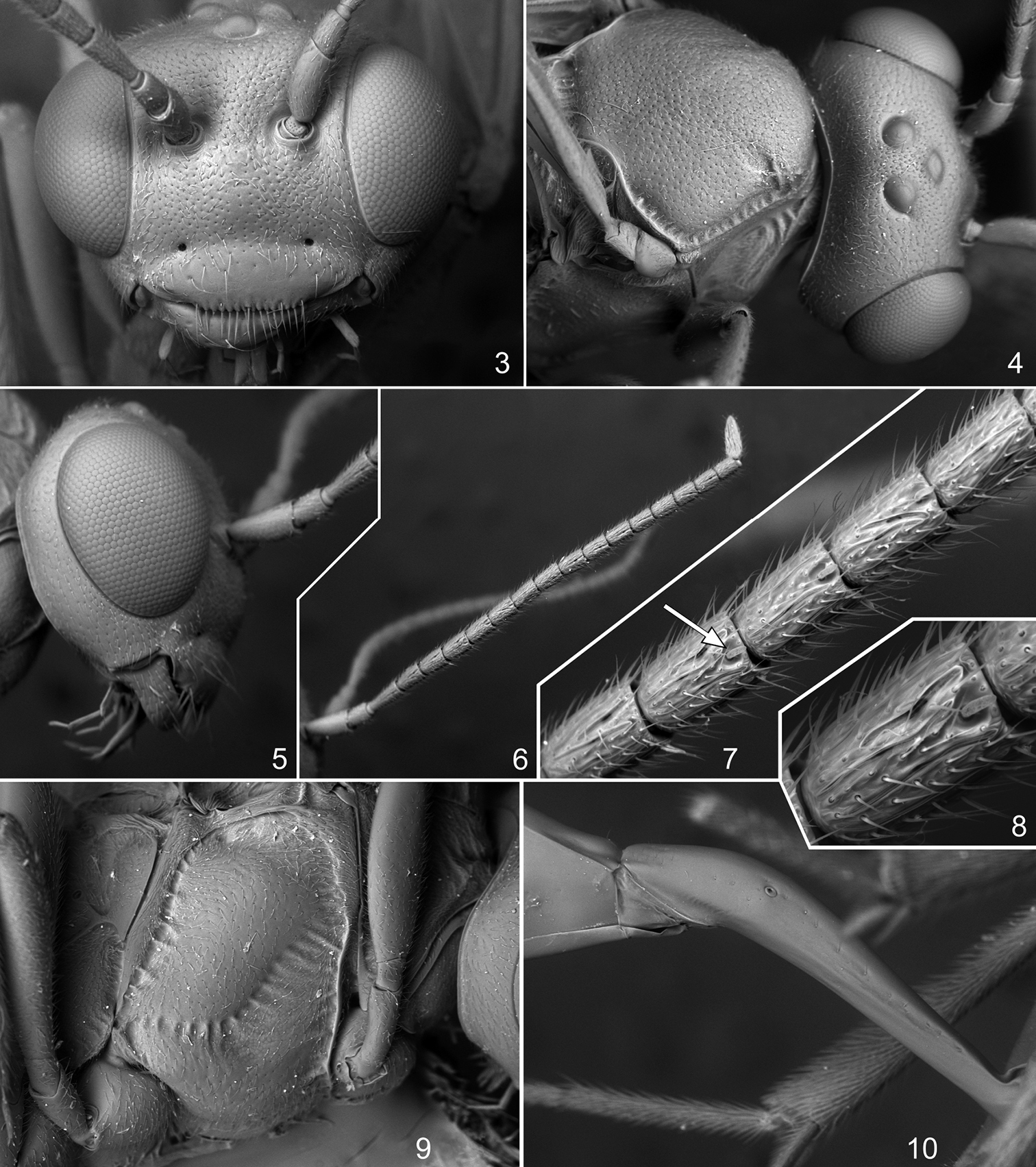






(C) 2012 Andrey I. Khalaim. This is an open access article distributed under the terms of the Creative Commons Attribution License 3.0 (CC-BY), which permits unrestricted use, distribution, and reproduction in any medium, provided the original author and source are credited.
For reference, use of the paginated PDF or printed version of this article is recommended.
One new species of the genus Phradis, Phradis peruvianus sp. n., from the mountainous part of Peruvian Amazonia, is described and illustrated. This is the first record of the genus from South America and the Neotropical region.
Peru, Western Amazonia, Phradis, new species, taxonomy
Phradis Förster, 1869 is one of the most species rich genera of Tersilochinae with almost world wide distribution (not recorded from the Neotropical and Oriental regions and absent in New Zealand). The genus is best represented in the Holarctic region and comprises 38 species in the Palaearctic region (
The genus belongs to the “Phradis” group of genera as well as the genera Allophrys Förster and Heterocola Förster (
Some species of Phradis are common parasitoids of sap beetle larvae (Coleoptera: Nitidulidae: Meligethes spp.) on rape in Europe (
Studying large quantities of material of Tersilochinae from Western Amazonia, a new species of the genus has been found from the mountainous Peruvian Amazonia.
Material and methodsAbout 530 specimens of Tersilochinae from the ichneumonid collections of the Zoological Museum of University of Turku, Finland, the Entomological Museum Klaus Raven Büller of Universidad Nacional Agraria la Molina, Lima, Peru, and the Entomological Collection of the University of Alicante, Spain, collected in Western Amazonia (Ecuador and Peru) in 1994–2010, have been studied. Material of Phradis was collected in Poromate basin (Quillabamba, La Convención Prov., Cusco Dept., Peru), a premontane area at 1, 600 m a.s.l., mostly covered with a closed to open broadleaved evergreen or semi-deciduous subtropical dry forest. The climate is classified as dry sub-humid (dry winter, warm summer). The soil in the area is high in leptosols with a weakly developed shallow soil.
Morphological terminology predominantly follows
The type material of the new species described in the present paper is deposited in the Museo de Entomología Klaus Raven Büller (MEKRB), in the Entomological Collection of University of Alicante (CEUA), and in the Zoological Institute of Russian Academy of Sciences, St. Petersburg, Russia (ZISP).
Layer photos were taken in the Zoological Museum of University of Turku, Finland, using an Olympus SZX16 stereomicroscope attached to an Olympus E520 digital camera. Digital photos were combined by using the software Deep Focus 3.1. Scanning electron microscope images were taken in the University of Alicante using a Hitachi S-3000N in low vacuum mode. All images were assembled and edited with Adobe Photoshop CS2 software.
Resultsurn:lsid:zoobank.org:act:98014132-8082-4A52-ADFF-E44B5B1EEDB6
http://species-id.net/wiki/Phradis_peruvianus
Figs 1–10Differs from other species of the genus by the extremely deep and broad foveate groove of mesopleuron extending from anterior margin of mesopleuron to base of mid coxa (Fig. 9). It is also characterized by the slender, black, 17-segmented flagellum (Fig. 6), propodeum with broad, impressed, longitudinally wrinkled basal area (basal longitudinal carinae indistinct), and fore wing with interstitial or slightly antefurcal second recurrent vein.
Phradis peruvianus sp. n. 1 holotype 2 paratype.<br/>
Female. Body length 4.6 mm. Fore wing length 3.8 mm.
Head. Roundly narrowed behind eyes in dorsal view; temple 0.42–0.48 times as long as eye width (Fig. 4). Distance between lateral ocellus and eye 2.2 times the maximum diameter of ocellus. Upper tooth of mandible much longer and broader than lower tooth. Clypeus lenticular, mostly smooth, finely punctate near its upper margin, with few larger punctures in its upper half and apical margin with a row of long setae (Fig. 3). Malar space 0.6 times as long as basal width of mandible. Flagellum of antenna with 17 flagellomeres (Fig. 6); second flagellomere almost twice as long as broad, subapical flagellomere about 1.6 times as long as broad; flagellomeres 4–6 bearing finger-shaped structures near apex on outer surface (Figs 7, 8). Inner eye orbits slightly convergent ventrally. Face and frons densely punctate on a granulate background. Vertex matt, finely punctate-granulate. Temple finely punctate, more or less smooth between punctures. Occipital carina complete.
Mesosoma. Notaulus short, rather deep, with strong wrinkle (Fig. 4). Mesoscutum densely punctate on a granulate background. Scutellum with lateral longitudinal carinae reaching from its base to about posterior 0.5. Foveate groove of mesopleuron extending from anterior margin of mesopleuron to base of mid coxa, deep, anteriorly very broad and with strong transverse wrinkles, posteriorly narrow and crenulate (Fig. 9). Mesopleuron predominantly smooth, with fine, moderately dense punctures. Propodeum granulate, dull, dorsolateral area very finely punctate, apical area with more or less distinct fine transverse wrinkles. Basal part of propodeum short, 0.25–0.27 times as long as apical area. Basal longitudinal carinae indistinct, propodeum dorsally with broad impressed area with few longitudinal wrinkles. Propodeal spiracle very small, round; distance between spiracle and pleural carina equal to about 3.0 diameters of spiracle. Apical area flat, anteriorly broadly rounded, sometimes slightly truncated.
Wings. Fore wing with second recurrent vein interstitial or slightly antefurcal, unpigmented in its anterior about 0.4. Intercubitus rather long. First abscissa of radius straight, distinctly longer than width of pterostigma. Metacarpus almost reaching apex of fore wing. Hind wing with nervellus slightly inclivous.
Legs. Hind femur 4.6 times as long as broad, and 0.82–0.84 times as long as tibia. Hind spurs almost straight, slightly curved at apex. Tarsal claws not pectinate.
Metasoma. First tergite slender, 4.7 times as long as posteriorly broad, smooth and shiny; down-curved from level of spiracle to the end of postpetiole, with some striae laterally, round in transverse cross-section (Fig. 10). Glymma absent. Second tergite 1.9–2.0 times as long as anteriorly broad. Thyridial depression about twice as long as broad. Ovipositor upcurved, thin, with shallow, dorsal, subapical depression; sheath about 1.8 times as long as first tergite and 1.85–1.92 times as long as hind tibia.
Coloration. Head, mesosoma (including tegula) and flagellum of antenna black; clypeus slightly brownish in its lower part; palpi, mandible (teeth blackish), scape and pedicel of antenna and legs reddish brown. Pterostigma and metasoma dark brown to brownish black.
Male unknown.
Phradis peruvianus sp. n. 3 head, frontal view 4 head and mesoscutum, dorsal view 5 head, lateral view 6 antenna, lateral view 7 flagellomeres 3–7 of antenna, lateral view 8 flagellomere 4 of antenna, lateral view 9 mesopleuron, lateral view 10 base of metasoma, lateral view.
All specimens are very similar in structure and colour, without obvious variation.
Holotype female, Peru, Cuzco Prov., La Convención, Quillabamba, Poromate, 1600 m, 12.XII.2007, leg. A. Rodríguez (MEKRB). Paratypes: one female with same data as holotype (CEUA), one female with same data except 11.XI.2007 (ZISP).
Peru (Cuzco).
The species name means “from Peru”.
Very little is known about Tersilochinae of the Neotropical Region. Only eight species of Stethantyx Townes (
The genus Phradis has almost a world wide distribution but is not recorded from the Neotropical and Oriental regions and is also absent in New Zealand (Khalaim pers. obs.), although it is quite possible that representatives of this genus may be found in the Oriental region, as some other large Palaearctic tersilochine genera (Barycnemis Förster, Probles Förster and Tersilochus Holmgren) are represented by one or few species in this region (
In North America only the species Phradis kasparyani Khalaim was described from California, U.S.A. (
Regarding the morphology of the new species we can highlight the possession, near the apex of the outer surface of flagellomeres 4–6, of finger-shaped structures. Such structures also were recently described in two European species of Phradis (
We sincerely appreciate the collaboration of Dr. Alexander Rodríguez-Berrío (Universidad Nacional Agraria la Molina, Lima, Peru) who collects and provides the material of the new species for study. We also want to express our sincere gratitude to Dr Ilari Sääksjärvi (University of Turku, Finland) for loan of valuable tersilochine material and for his help in taking layered digital pictures of species habitus. We are thankful to two anonymous referees for their criticism and important suggestions. This work was supported by the Russian Foundation for Basic Research (No. 10-04-00265), by the Presidium of the Russian Academy of Sciences Programme “Origin and Evolution of Biosphere, Subprogram II”, and by Project A/013484/07 from Agencia Española de Cooperación Internacional para el Desarrollo (Ministerio de Asuntos Exteriores y de Cooperación, Spain). A research visit made by the second author to the Universidad Nacional Agraria la Molina (Lima, Peru), was supported by a grant from University of Alicante, Spain (Vicerrectorado de Relaciones Internacionales y Cooperación, Programa Propio para el Fomento de las Relaciones Institucionales, 2010).

